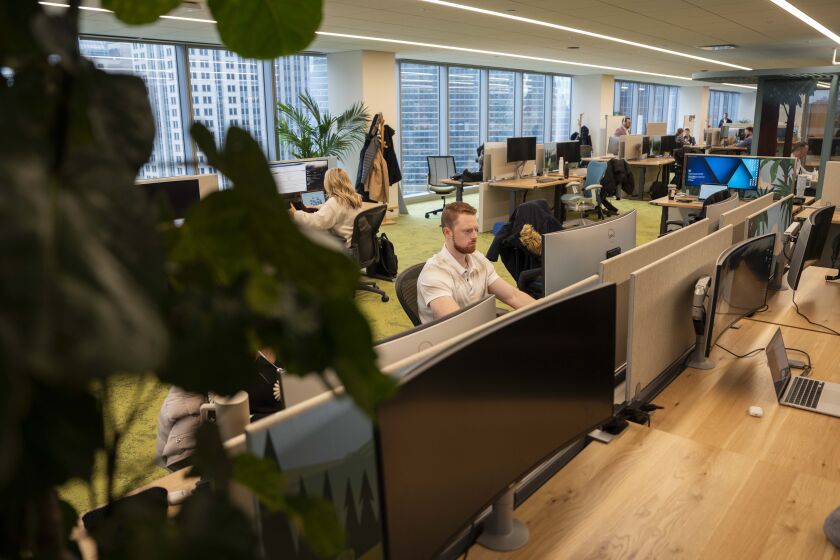During the worst of the pandemic when offices were eerily empty, some wondered if Salesforce was still gung-ho about anchoring a 60-story office building in Chicago.
On Tuesday, the software provider answered that with a jaunty “yes,” showing off its new quarters at Salesforce Tower Chicago in Wolf Point, near the Merchandise Mart, with a design that executives say demonstrates a commitment to employees and the community.
The 360,000-square-foot office over 14 floors are Salesforce’s “culture and values come to life,” said Relina Bulchandani, the company’s executive vice president of real estate and workplace services. “We have been really focused on learning through the pandemic how employees want to work today.”
The result is space without fancy corner offices for top brass, and an array of employee gathering spaces, nooks for libraries and nursing parents, and “mindfulness rooms” for staffers who want to escape technology and meditate. “It’s part of our culture. There’s nothing strange about doing this,” Bulchandani said.
The company also wasn’t satisfied with office plants to suggest the great outdoors. It has “green columns” wrapped in verdure.
To top it off, literally: On the two highest occupied floors, Salesforce formally opened its ‘Ohana floors, space available during the day as a workplace retreat. The company moved its first workers into the building in May.
On nights and weekends, the ‘Ohana floors — on the 56th and 57th level — are offered rent-free to nonprofit organizations. ‘Ohana is a Hawaiian term meaning family, but with a broader connotation covering more than blood relatives.
San Francisco-based Salesforce cut the ribbon on the ‘Ohana floors Tuesday during a celebration that included Mayor Brandon Johnson. It was a morale boost for Chicago promoters dealing with critics who say rising crime and City Hall policies are making businesses leery of investing here.
None of that flak was voiced at the ribbon-cutting, which featured invocations from five religious leaders and public acknowledgments of the Wolf Point land’s legacy to Native Americans, although no one offered to give it back.
“We’re celebrating something that is, I think, quite profound,” Johnson said. “The opportunity for our collective approach toward economic development … can be tied to your value system. You know, it’s not a pipe dream to believe that that type of structure can exist.”
The mayor said he was “thrilled to see any company thrive in our great city, particularly one that is mission-driven.”
Sabastian Niles, Salesforce president and chief legal officer, said the company has donated $16 million to Chicago-area organizations. He announced an additional gift of $1.25 million shared by two organizations that support Chicago students’ mental and emotional health, CASEL and Peer Health Exchange.
Salesforce once promised to have 1,000 employees here. Executives said the company has 2,200 workers assigned to the Wolf Point tower, with about 800 visiting the building on a given day.
Bulchandani said Salesforce is flexible about allowing people to work from home or elsewhere, with schedules determined by individual teams. Conference rooms are equipped to allow remote workers to participate in meetings.
The company’s main concession to the pandemic was to reduce its appetite for space. It originally leased 500,000 square feet in the building, at 333 W. Wolf Point Plaza, but has made 140,000 square feet available for sublease.
The other principal tenant in the tower is the law firm Kirkland & Ellis.
Bulchandani said Salesforce was optimistic about growth prospects in Chicago.
“We have amazing talent here with all the universities,” she said.
With recently improved earnings, Salesforce has been reported to be on a hiring binge after laying off about 8,000 workers, 10% of its total staff, earlier in 2023.
The development firm Hines built Salesforce Tower Chicago, which is the third and final building on Wolf Point. It worked in partnership with the politically renowned Kennedy family, former owners of Wolf Point and the Merchandise Mart. Architecture firm Pelli Clarke Pelli designed the building.








